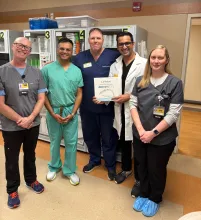Pancreatic Disorders
- For all other requests:
- 1-800-777-8442
Pancreatitis is the inflammation of the pancreas, the large gland behind the stomach and close to the first part of the small intestine. The pancreas secretes enzymes that join with bile, a liquid produced in the liver and stored in the gallbladder to digest food.
Pancreatitis can be acute or chronic. Either form is serious and can lead to complications. In severe cases, bleeding, infection, and permanent tissue damage may occur.
Our digestive disease experts work as a team to diagnose and treat your disorders and to manage related conditions.
Conditions Treated
- Ascending cholangitis (non malignant)
- Biliary disease
- Common bile duct/cancer/cholangiocarcinomas (malignant)
- Common bile duct stone (non malignant)
- Mirizzi syndrome (non malignant)
- Pancreatic disease
- Pancreatic head mass (malignant)
- Pancreatic pseudocyst (non malignant)
- Sphincter oddi dysfunction (non malignant)
Testing Options
- CBC
- CT scan
- HIDA scan
- Liver panel
- MRCP
- Endoscopic ultrasound
Treatment Options
- Stent placement
- Therapeutic endoscopy - ERCP
Diseases of the Pancreas
These are rare tumors. They are most often sporadic (not inherited), but some may be part of inherited syndromes such as MEN or Von Hippel-Lindau.
These tumors do not produce hormones that cause symptoms. Therefore they are usually discovered late. If the disease has not spread outside of the pancreas, the best treatment is usually surgery.
These tumors produce gastrin, which can lead to ulcers and diarrhea, known as Zollinger-Ellison syndrome. The tumors are found in the “gastrinoma triangle”, which encompasses the duodenum and the head of the pancreas. They sometimes spread to lymph nodes, liver and other organs. Gastrinomas may be part of the MEN1 syndrome.
These tumors produce insulin, which leads to profound hypoglycemia and symptoms of mental status changes, and loss of consciousness. The symptoms disappear with eating sugary foods. Most (90%) are benign. They are often difficult to diagnose and localize. Insulinomas may be part of the MEN1 syndrome.
Additional very rare tumors include somatostatinomas, VIPomas, and glucagonomas.
Endocrine Pancreas Surgery
Many pancreatic neuroendocrine tumors may be removed with enucleation, which essentially shells out the tumor from the pancreas gland. However, removal of part of the gland is sometimes required. A pancreaticoduodenectomy or Whipple procedure removes the head of the pancreas, and a distal pancreatectomy removes the body and tail of the pancreas.
Endocrine pancreas surgery pre- and post-operative care
Preoperative preparation for pancreas surgery
Patients with functional neuroendocrine tumors of the pancreas will need to have the effects of hormone excess controlled prior to surgery. For example, patients with gastrinomas will need to be on proton pump inhibitors perioperatively. Patients with insulinomas will need to be admitted overnight to the hospital for IV glucose infusions and frequent glucose determinations while they are NPO (nothing by mouth) prior to surgery.
Our Care Team






- Gastroenterology



- Cancer
Not sure which Pancreatic Disorders provider is right for you?
Locations and Offices

Related News
